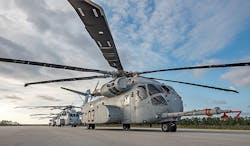King Stallion: the future of U.S. Marine Corps heavy lift helicopters for airborne resupply
NATIONAL HARBOR, Md. – U.S. Marine Corps Col. Hank Vanderborght, program manager for the Naval Air Systems Command (NAVAIR) Heavy LiftHelicopters program office, says the new Sikorsky CH-53K King Stallion helicopters will “exceed all parameters” for performance.
The 53K is scheduled to reach initial operational capability next year and deploy to Marine Corps air wings in 2023. It’s expected to be able to lift nearly 14 tons -- triple the lift capacity of the current heavy-lift chopper the CH-53E -- and then fly 110 nautical miles at an altitude of 3,000 feet in high-heat conditions.
In early March a test aircraft lifted a 36,000-pound external payload into a hover at the Sikorsky Development Flight Center on its centerpoint cargo hook. The lift test marked the completion of critical envelope expansion testing, defining the final performance envelope.
The aircraft, which has attracted interest from Germany and Israel, is the “future of heavy lift, a true 21st century aircraft,” Vanderborght added in comments in April at the Navy League Sea-Air-Space conference and trade show in National Harbor, Md.
Germany and Israel are looking at fielding a new heavy lift helicopter between 2020 and 2025, he says. In March a CH-53K test aircraft was flown to Germany aboard an Air Force C-17 transport to participate in the Berlin Air Show in late April.
Marine Corps and Sikorsky officials say that the CH-53K’s performance is based on introduction of three key technologies: fourth generation rotor blades, 79 feet in diameter, a split-torque main rotor gearbox, and the General Electric T408 engine, which generates 7,500 shaft horsepower to the rotors. The airframe is “marinized” to protect it from exposure to saltwater and high EMI environments.
Vanderborght says that “mean time to repair (MTTR) has been a huge focus.” The design emphasized performance in hot environments, survivability, and safety.
The colonel disputed a report by the Defense Department director of test and evaluation that the program was experiencing problems and wouldn’t meet its scheduled 2019 initial operating capability.
“Those reports lag the program by six to eight months, all the deficiencies reported have been fixed,” he says.
The final test aircraft arrived at NAVAIR test facility at Patuxent River, Md., in early April. Testing will continue there, and some development work remains to be done, Vanderborght says, but planned IOC is not in jeopardy.
Ready to make a purchase? Search the Military & Aerospace Electronics Buyer's Guide for companies, new products, press releases, and videos

